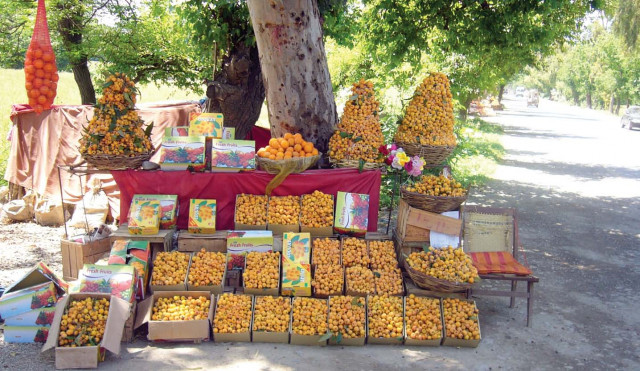Quench that thirst: The loquat season is here
The fruit is a sweet experience for consumers, though prices are proving somewhat sour.

Although seasonal changes like water shortage, attacks from pests and the lack of proper upkeep of loquat trees in Haripur district have affected the produce considerably, this season the crop is of better quality than the last two years.
“Yes, this time the crop is better than previous years and farmers are expecting to earn better income if the weather remains unchanged,” said Sher Afzal, a local farmer.
It was observed that the rates per kilogram have gone up. Last year a 5 kg carton was available in the local market for Rs200 to Rs250 but this time at the start of the crop the consumers are getting the same quantity with 80% to 90% increases in price.
“The cost of watering, picking, packing, transportation and security have witnessed an unprecedented increase, along of course with the fuel prices,” said Noor Elahi another fruit contractor who exports his produce to Punjab, where his earnings are considerably more than in his local market.
The district of Haripur has orchards of citrus, guava, lichee, loquat and others in an area of 1,292 acres, but the orchards of loquat alone are spread over 190 hectares with 1,884 tonnes of annual produce, according to the crop reporting centre’s statistics.
According to botanists loquat is of the rose family, Rosaceae, and has many names referring to its Japanese origins. To the Italians, it is nespola giapponese; to French-speaking people, it is néflier du Japon, or bibassier. In the German language, it is japanische mispel, or wollmispel; in Spanish, nispero, nispero japonés, or nispero del Japón; in Portuguese, ameixa amarella, or ameixa do Japao.
Loquat is grown in clusters of four to 30, is one to two inches long with smooth or downy, yellow to orange, sometimes red-blushed skin, and white, yellow or orange pulp, of sweet to subacid or acid flavour.
The loquat is indigenous to southeastern China and possibly southern Japan, though it may have been introduced into Japan in very early times. It is said to have been cultivated in Japan for over a thousand years. The western world first learned of it from the botanist Kaempfer in 1690. There are reportedly over 800 varieties of this fruit in the world while in the sub-continent we have over 11 varieties.
Pakistan has a favourable temperature and soil for growing the fruit. Indeed, it is the second biggest fruit after citrus that is exported to cities around the country. In Pakistan Loquat start ripening by the end of March and remain in the market till May.
According to horticulture experts and local farmers the Loquats reach maturity in 90 days, with the full development of colour for each cultivar the best guide to ripeness. It also has medicinal advantages, which experts believe acts as a sedative and is eaten to stop vomiting and thirst. Some local Hakeems also advise diabetics to eat loquat.
Hundreds of labourers are engaged annually in the process of its watering, picking, packing and transportation to other cities. Roadside makeshift kiosks on Abbottabad Road, Khanpur-Taxila Road are another source of livelihood for the local farmers that attract the attention of travellers.
Published in The Express Tribune, April 23rd, 2012.


















COMMENTS
Comments are moderated and generally will be posted if they are on-topic and not abusive.
For more information, please see our Comments FAQ